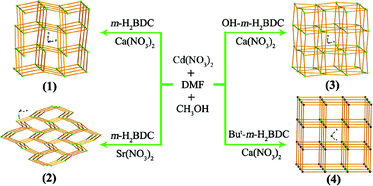Syntheses, topological analyses, and NLO-active properties of new Cd(ii)/M(ii) (M = Ca, Sr) metal–organic frameworks based on R-isophthalic acids (R = H, OH, and t-Bu)†
Abstract
Solvothermal syntheses of Cd(NO3)2·4H2O and R-isophthalic acids (R = H, OH and t-Bu) in the presence of Ca(II) or Sr(II) lead to four new three-dimensional Cd(II)/Ca(II) or Cd(II)/Sr(II) heterometallic frameworks: [CdCa(m-BDC)2(DMF)2] (1), [CdSr2(m-BDC)2(NO3)2(DMF)4] (2), [CdCa(OH-m-BDC)2(H2O)2]·2Me2NH (3), and (Me2NH2)2[Cd2Ca(But-m-BDC)4] (4) (m-H2BDC = isophthalate, OH-m-H2BDC = 5-hydroxyisophthalate and But-m-H2BDC = 5-butylisophthalate). All of these compounds except for 4 crystallize in acentric (or chiral) space groups and the bulk materials for 1 and 3 display strong powder SHG efficiencies, approximately 1.54 and 2.31 times than that of a potassium dihydrogen phosphate (KDP) powder. Topological analyses show that 1 and 2 have structures with sxb and dia topologies, respectively, while both 3 and 4 exhibit pcu topological nets when the metal carboxylate clusters are viewed as nodes. The fluorescence properties and thermal stabilities for these compounds are also investigated.


 Please wait while we load your content...
Please wait while we load your content...